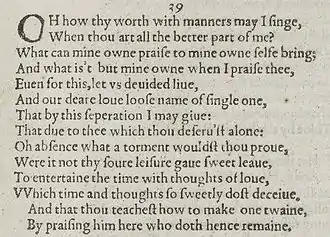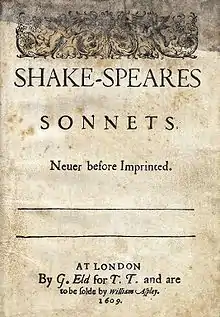Sonnet 39
Sonnet 39 is one of 154 sonnets written by the English playwright and poet William Shakespeare. It is a member of the Fair Youth sequence, in which the poet expresses his love towards a young man.
| Sonnet 39 | |||||||
|---|---|---|---|---|---|---|---|
 Sonnet 39 in the 1609 Quarto | |||||||
| |||||||
Structure
Sonnet 39 is an English or Shakespearean sonnet, composed of three quatrains and a final rhyming couplet for a total of fourteen lines. It follows the rhyme scheme ABAB CDCD EFEF GG. It is written in iambic pentameter, a metre based on five pairs of syllables accented weak/strong. The second line is one example of a line of regular iambic pentameter:
× / × / × / × / × / O, how thy worth with manners may I sing
- / = ictus, a metrically strong syllabic position. × = nonictus.
The fifth line can be scanned with an initial reversal:
/ × × / x / × / × / Even for this, let us divided live, (39.5)
Themes
Sonnet 39 continues with sonnets 35–37 the theme of the poet and the young man being united in love as one person and the suggestion of being separated (twain): “How can I praise you properly when we are so combined? I would be praising, in a sense, myself.” The poet suggests that a separation will help him praise the young man while thinking of his admirable aspects in absence. Beginning with line 9 the poet addresses not the youth, but “absence”: “Oh absence, you would be torment, except that you provide a pleasant opportunity to think on love, and, absence, you teach one to be not solitary but to be two, by praising the young man where I am, though he continues to be elsewhere (hence).”[2]
Notes
Further reading
- First edition and facsimile
- Shakespeare, William (1609). Shake-speares Sonnets: Never Before Imprinted. London: Thomas Thorpe.
- Lee, Sidney, ed. (1905). Shakespeares Sonnets: Being a reproduction in facsimile of the first edition. Oxford: Clarendon Press. OCLC 458829162.
- Variorum editions
- Alden, Raymond Macdonald, ed. (1916). The Sonnets of Shakespeare. Boston: Houghton Mifflin Company. OCLC 234756.
- Rollins, Hyder Edward, ed. (1944). A New Variorum Edition of Shakespeare: The Sonnets [2 Volumes]. Philadelphia: J. B. Lippincott & Co. OCLC 6028485.
- Modern critical editions
- Atkins, Carl D., ed. (2007). Shakespeare's Sonnets: With Three Hundred Years of Commentary. Madison: Fairleigh Dickinson University Press. ISBN 978-0-8386-4163-7. OCLC 86090499.
- Booth, Stephen, ed. (2000) [1st ed. 1977]. Shakespeare's Sonnets (Rev. ed.). New Haven: Yale Nota Bene. ISBN 0-300-01959-9. OCLC 2968040.
- Burrow, Colin, ed. (2002). The Complete Sonnets and Poems. The Oxford Shakespeare. Oxford: Oxford University Press. ISBN 978-0192819338. OCLC 48532938.
- Duncan-Jones, Katherine, ed. (2010) [1st ed. 1997]. Shakespeare's Sonnets. The Arden Shakespeare, Third Series (Rev. ed.). London: Bloomsbury. ISBN 978-1-4080-1797-5. OCLC 755065951.
- Evans, G. Blakemore, ed. (1996). The Sonnets. The New Cambridge Shakespeare. Cambridge: Cambridge University Press. ISBN 978-0521294034. OCLC 32272082.
- Kerrigan, John, ed. (1995) [1st ed. 1986]. The Sonnets ; and, A Lover's Complaint. New Penguin Shakespeare (Rev. ed.). Penguin Books. ISBN 0-14-070732-8. OCLC 15018446.
- Mowat, Barbara A.; Werstine, Paul, eds. (2006). Shakespeare's Sonnets & Poems. Folger Shakespeare Library. New York: Washington Square Press. ISBN 978-0743273282. OCLC 64594469.
- Orgel, Stephen, ed. (2001). The Sonnets. The Pelican Shakespeare (Rev. ed.). New York: Penguin Books. ISBN 978-0140714531. OCLC 46683809.
- Vendler, Helen, ed. (1997). The Art of Shakespeare's Sonnets. Cambridge, MA: The Belknap Press of Harvard University Press. ISBN 0-674-63712-7. OCLC 36806589.
.png.webp)

